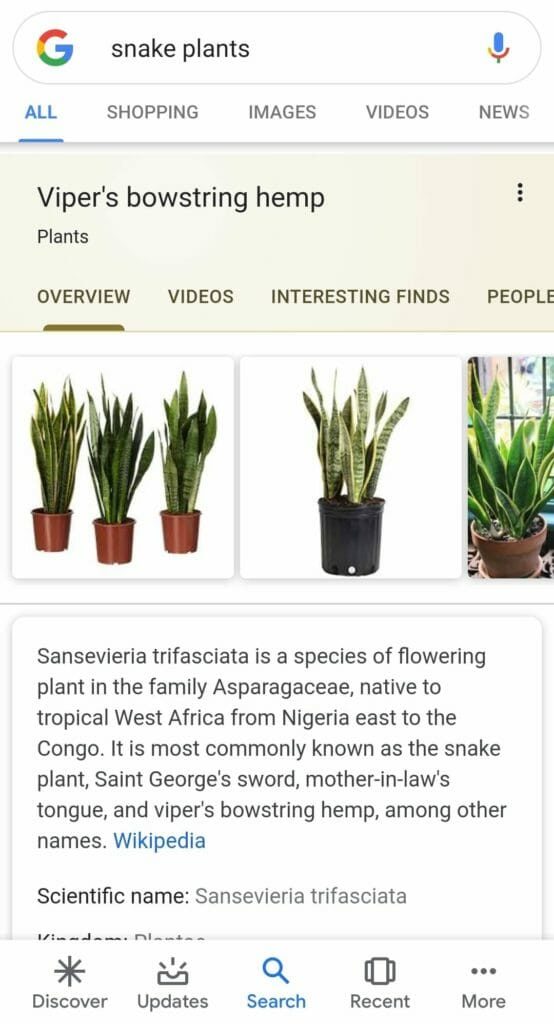Latent semantic indexing (LSI) is a complex system used by search engines to analyze the relationships between terms and concepts on a page in an effort to provide the most accurate and relevant search results.
The importance of latent semantic indexing for search
Latent semantic indexing uses natural language processing (NLP) to help a search engine determine relevant content for a specific search query.
Let’s say you are searching the term “snake plants.” Obviously, on their own, these words mean very different things and when they are put together, they mean something else entirely. So, how is it that a search engine knows to return results related to the Sansevieria trifasciata plant and not results related to snakes, or plants, in general?

Search engines will use LSI keywords to give context to pages containing the words “snake plants” and provide relevant results. Pages about snake plants are likely to also contain LSI keywords like “sunlight,” “soil,” and “growing conditions,” allowing search engines to find relevant pages based on the user’s search intent that’s signaled by the search query.
For those looking to improve their digital marketing efforts, LSI keywords should be included as part of any SEO strategy.
Creating relevant content for your marketing strategy is essential for ranking, capturing traffic, and increasing conversions. Using semantically related terms, which LSI keywords are, can help improve the relevancy of your page and increase organic search traffic.
But more than just improving SEO, LSI helps to categorize content, making searches more effective and productive for everyone from marketer to publisher to user. Content that is developed with LSI in mind can establish a more targeted piece of content that will appear to (and appeal to!) the right audience. At the same time, LSI-based content enables users to find the content that relates to their specific search queries more quickly and easily.
How does LSI work?
First developed in the 1980s, latent semantic indexing was an algorithm created to help artificial intelligence understand the structure and meaning of language. This technique, singular value decomposition, gave AI the ability to process information, catalog and index it, and retrieve content relevant to what’s been processed. Sound familiar?
In other words, LSI helps search engines understand nuance. It works to place terms and phrases into categories and give them the ability to see the context of content created.
Through conducting a semantic analysis, LSI almost acts like its own little search engine. It recognizes ‘keyword A’ and comes to “understand” that when it finds that keyword, it is also likely to find the related keywords ‘B,’ ‘C,’ and ‘D’ nearby.
An understanding of LSI can help search engines categorize and rank your pages, but it shouldn’t be the entire foundation of your search engine optimization strategy. Search engines have evolved so much that LSI is only a part of its analysis.
In fact, search engines have become so intelligent that they are penalizing pages overloaded with keywords (This is known as keyword stuffing). These pages rank lower or are completely removed from search listings.
Search engines want to match users with quality content that is most useful and relevant to their specific query. So, when content creators try to fool the algorithm by filling their text with keywords, they produce a page that doesn’t read naturally and is often devoid of value. This type of content will not properly satisfy a user’s search query.
No one wants to read content that repeats a specific keyword over and over again without actually saying anything.
Keywords, both short and long-tail, should always be used as naturally as possible in your content. If they do not fit a particular sentence or context, do not try to wedge them in there. Primary keywords are obviously essential but related keywords can be just as useful when used in a natural way. Take the above snake plant example, it is not necessary to use “snake plants” in every single sentence. By organically including related terms like “watering schedule” or “potted plant,” you will provide the context necessary to appear in the appropriate searches.
To learn more about how call analytics can improve your business, request your no obligation demo of CallRail, or go ahead and start your 14 Day Free Trial.
The post What is latent semantic indexing? appeared first on CallRail.

